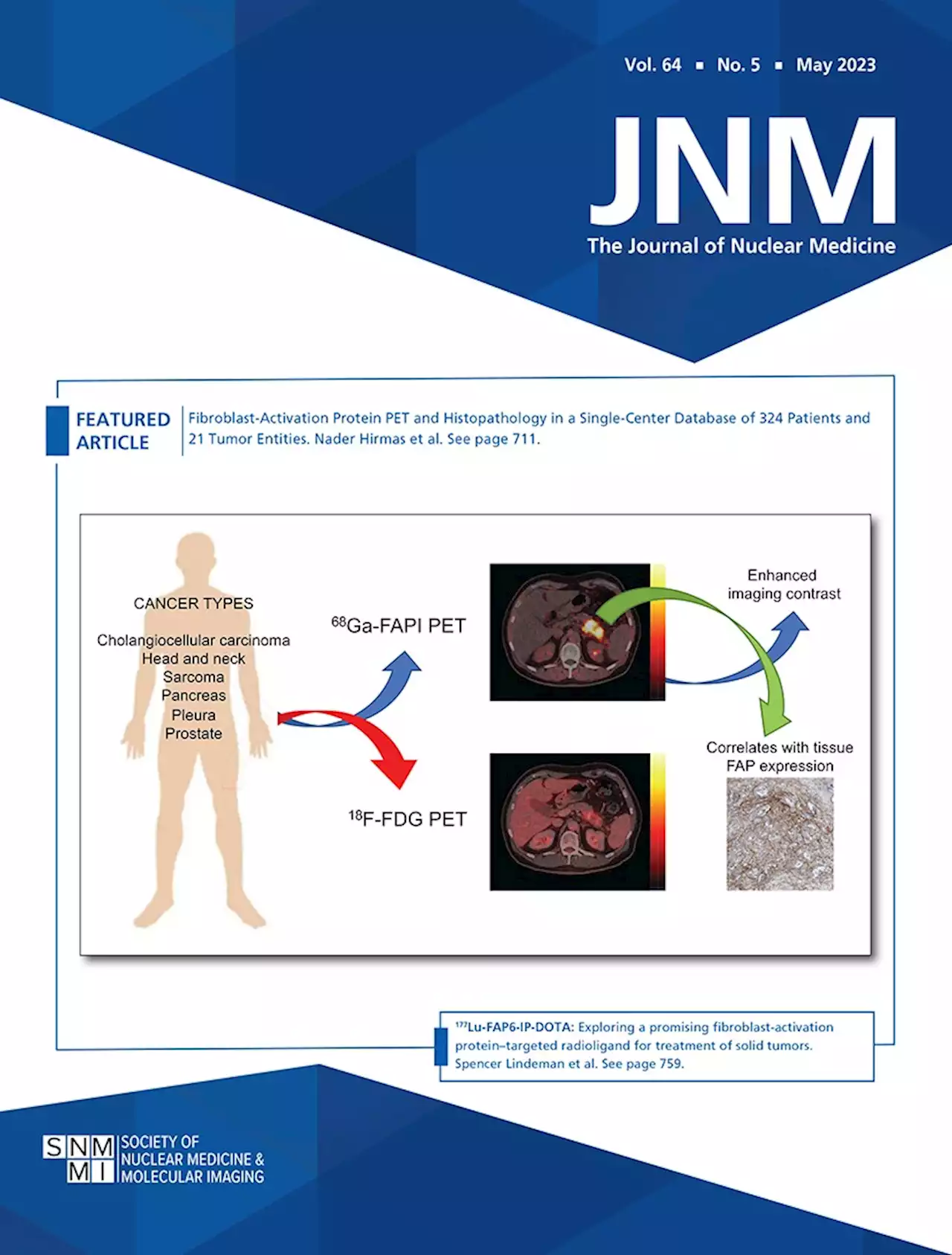A Review in Cancer Cell International states that miRNAs increase the cisplatin (CDDP) sensitivity through inhibition of autophagy, thus suggesting them as efficient therapeutic options to enhance the autophagy-mediated CDDP sensitivity in tumor cells.
Belgique Dernières Nouvelles, Belgique Actualités
Similar News:Vous pouvez également lire des articles d'actualité similaires à celui-ci que nous avons collectés auprès d'autres sources d'information.
 2 early signs of pancreatic cancer that's dubbed 'silent disease'The cancer has one of the lowest 10-year survival rates of any cancer.
2 early signs of pancreatic cancer that's dubbed 'silent disease'The cancer has one of the lowest 10-year survival rates of any cancer.
Lire la suite »
 Fibroblast-Activation Protein PET and Histopathology in a Single-Center Database of 324 Patients and 21 Tumor EntitiesWe present an overview of our prospective fibroblast-activation protein inhibitor (FAPI) registry study across a 3-y period, with head-to-head comparison of tumor uptake in 68Ga-FAPI and 18F-FDG PET, as well as FAP immunohistochemistry. Methods: This is an interim analysis of the ongoing 68Ga-FAPI PET prospective observational trial at our department. Patients who underwent clinical imaging with 68Ga-FAPI PET between October 2018 and October 2021 were included. Tracer uptake was quantified by SUVmax for tumor lesions and by SUVmean for normal organs. PET tumor volume (40% isocontour) and tumor-to-background ratios were calculated. Correlation between SUVmax and FAP staining in tissue samples was analyzed. Results: In total, 324 patients with 21 different tumor entities underwent 68Ga-FAPI imaging; 237 patients additionally received 18F-FDG PET. The most common tumor entities were sarcoma (131/324, 40%), pancreatic cancer (67/324, 21%), and primary tumors of the brain (22/324, 7%). The mean primary tumor SUVmax was significantly higher for 68Ga-FAPI than 18F-FDG among pancreatic cancer (13.2 vs. 6.1, P | 0.001) and sarcoma (14.3 vs. 9.4, P | 0.001), and the same was true for mean SUVmax in metastatic lesions of pancreatic cancer (9.4 vs. 5.5, P | 0.001). Mean primary tumor maximum tumor-to-background ratio was significantly higher for 68Ga-FAPI than 18F-FDG across several tumor entities, most prominently pancreatic cancer (14.7 vs. 3.0, P | 0.001) and sarcoma (17.3 vs. 4.7, P | 0.001). Compared with 18F-FDG, 68Ga-FAPI showed superior detection for locoregional disease in sarcoma (52 vs. 48 total regions detected) and for distant metastatic disease in both sarcoma (137 vs. 131) and pancreatic cancer (65 vs. 57), respectively. Among 61 histopathology samples, there was a positive correlation between 68Ga-FAPI SUVmax and overall FAP immunohistochemistry score ( r=0.352, P=0.005). Conclusion: 68Ga-FAPI demonstrates higher absolute uptake in pancreatic cancer and sarcoma,
Fibroblast-Activation Protein PET and Histopathology in a Single-Center Database of 324 Patients and 21 Tumor EntitiesWe present an overview of our prospective fibroblast-activation protein inhibitor (FAPI) registry study across a 3-y period, with head-to-head comparison of tumor uptake in 68Ga-FAPI and 18F-FDG PET, as well as FAP immunohistochemistry. Methods: This is an interim analysis of the ongoing 68Ga-FAPI PET prospective observational trial at our department. Patients who underwent clinical imaging with 68Ga-FAPI PET between October 2018 and October 2021 were included. Tracer uptake was quantified by SUVmax for tumor lesions and by SUVmean for normal organs. PET tumor volume (40% isocontour) and tumor-to-background ratios were calculated. Correlation between SUVmax and FAP staining in tissue samples was analyzed. Results: In total, 324 patients with 21 different tumor entities underwent 68Ga-FAPI imaging; 237 patients additionally received 18F-FDG PET. The most common tumor entities were sarcoma (131/324, 40%), pancreatic cancer (67/324, 21%), and primary tumors of the brain (22/324, 7%). The mean primary tumor SUVmax was significantly higher for 68Ga-FAPI than 18F-FDG among pancreatic cancer (13.2 vs. 6.1, P | 0.001) and sarcoma (14.3 vs. 9.4, P | 0.001), and the same was true for mean SUVmax in metastatic lesions of pancreatic cancer (9.4 vs. 5.5, P | 0.001). Mean primary tumor maximum tumor-to-background ratio was significantly higher for 68Ga-FAPI than 18F-FDG across several tumor entities, most prominently pancreatic cancer (14.7 vs. 3.0, P | 0.001) and sarcoma (17.3 vs. 4.7, P | 0.001). Compared with 18F-FDG, 68Ga-FAPI showed superior detection for locoregional disease in sarcoma (52 vs. 48 total regions detected) and for distant metastatic disease in both sarcoma (137 vs. 131) and pancreatic cancer (65 vs. 57), respectively. Among 61 histopathology samples, there was a positive correlation between 68Ga-FAPI SUVmax and overall FAP immunohistochemistry score ( r=0.352, P=0.005). Conclusion: 68Ga-FAPI demonstrates higher absolute uptake in pancreatic cancer and sarcoma,
Lire la suite »
 Classifying cancer cells to predict metastatic potentialCancer cells that initiate metastasis, or the spread of the disease from its primary location, are different from cancer cells that stay in the original tumor. Distinguishing metastasis-initiating cell types can determine the severity of cancer and help medical practitioners decide on a course of treatment.
Classifying cancer cells to predict metastatic potentialCancer cells that initiate metastasis, or the spread of the disease from its primary location, are different from cancer cells that stay in the original tumor. Distinguishing metastasis-initiating cell types can determine the severity of cancer and help medical practitioners decide on a course of treatment.
Lire la suite »
 Altered expression of anti-apoptotic protein Api5 affects breast tumorigenesis - BMC CancerBackground Apoptosis or programmed cell death plays a vital role in maintaining homeostasis and, therefore, is a tightly regulated process. Deregulation of apoptosis signalling can favour carcinogenesis. Apoptosis inhibitor 5 (Api5), an inhibitor of apoptosis, is upregulated in cancers. Interestingly, Api5 is shown to regulate both apoptosis and cell proliferation. To address the precise functional significance of Api5 in carcinogenesis here we investigate the role of Api5 in breast carcinogenesis. Methods Initially, we carried out in silico analyses using TCGA and GENT2 datasets to understand expression pattern of API5 in breast cancer patients followed by investigating the protein expression in Indian breast cancer patient samples. To investigate the functional importance of Api5 in breast carcinogenesis, we utilised MCF10A 3D breast acinar cultures and spheroid cultures of malignant breast cells with altered Api5 expression. Various phenotypic and molecular changes induced by altered Api5 expression were studied using these 3D culture models. Furthermore, in vivo tumorigenicity studies were used to confirm the importance of Api5 in breast carcinogenesis. Results In-silico analysis revealed elevated levels of Api5 transcript in breast cancer patients which correlated with poor prognosis. Overexpression of Api5 in non-tumorigenic breast acinar cultures resulted in increased proliferation and cells exhibited a partial EMT-like phenotype with higher migratory potential and disruption in cell polarity. Furthermore, during acini development, the influence of Api5 is mediated via the combined action of FGF2 activated PDK1-Akt/cMYC signalling and Ras-ERK pathways. Conversely, Api5 knock-down downregulated FGF2 signalling leading to reduced proliferation and diminished in vivo tumorigenic potential of the breast cancer cells. Conclusion Taken together, our study identifies Api5 as a central player involved in regulating multiple events during breast carcinogenesis includi
Altered expression of anti-apoptotic protein Api5 affects breast tumorigenesis - BMC CancerBackground Apoptosis or programmed cell death plays a vital role in maintaining homeostasis and, therefore, is a tightly regulated process. Deregulation of apoptosis signalling can favour carcinogenesis. Apoptosis inhibitor 5 (Api5), an inhibitor of apoptosis, is upregulated in cancers. Interestingly, Api5 is shown to regulate both apoptosis and cell proliferation. To address the precise functional significance of Api5 in carcinogenesis here we investigate the role of Api5 in breast carcinogenesis. Methods Initially, we carried out in silico analyses using TCGA and GENT2 datasets to understand expression pattern of API5 in breast cancer patients followed by investigating the protein expression in Indian breast cancer patient samples. To investigate the functional importance of Api5 in breast carcinogenesis, we utilised MCF10A 3D breast acinar cultures and spheroid cultures of malignant breast cells with altered Api5 expression. Various phenotypic and molecular changes induced by altered Api5 expression were studied using these 3D culture models. Furthermore, in vivo tumorigenicity studies were used to confirm the importance of Api5 in breast carcinogenesis. Results In-silico analysis revealed elevated levels of Api5 transcript in breast cancer patients which correlated with poor prognosis. Overexpression of Api5 in non-tumorigenic breast acinar cultures resulted in increased proliferation and cells exhibited a partial EMT-like phenotype with higher migratory potential and disruption in cell polarity. Furthermore, during acini development, the influence of Api5 is mediated via the combined action of FGF2 activated PDK1-Akt/cMYC signalling and Ras-ERK pathways. Conversely, Api5 knock-down downregulated FGF2 signalling leading to reduced proliferation and diminished in vivo tumorigenic potential of the breast cancer cells. Conclusion Taken together, our study identifies Api5 as a central player involved in regulating multiple events during breast carcinogenesis includi
Lire la suite »
 IAC’s Paul Burrell ‘living life to the fullest’ amid prostate cancer battleEXCLUSIVE: Paul Burrell was diagnosed with prostate cancer late last year and, following treatment, the I'm A Celeb star and former royal butler is determined to appreciate every day
IAC’s Paul Burrell ‘living life to the fullest’ amid prostate cancer battleEXCLUSIVE: Paul Burrell was diagnosed with prostate cancer late last year and, following treatment, the I'm A Celeb star and former royal butler is determined to appreciate every day
Lire la suite »
 Nine symptoms of ‘silent killer’ cancer women shouldn't ignoreThere are nine warning signs to look out for which could save your life if detected early
Nine symptoms of ‘silent killer’ cancer women shouldn't ignoreThere are nine warning signs to look out for which could save your life if detected early
Lire la suite »
